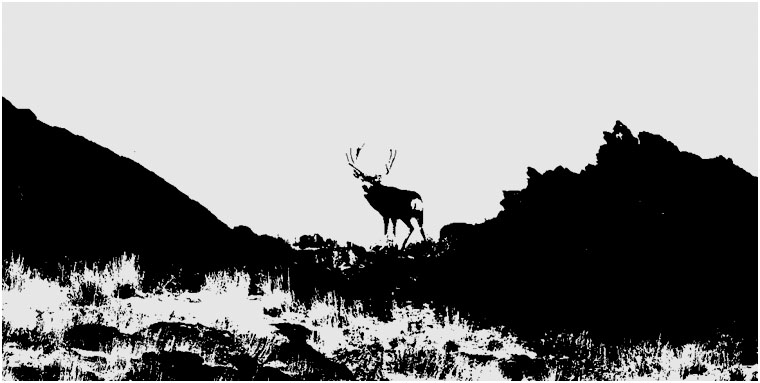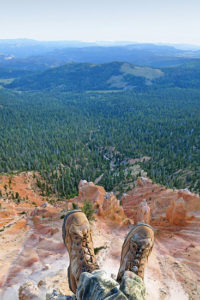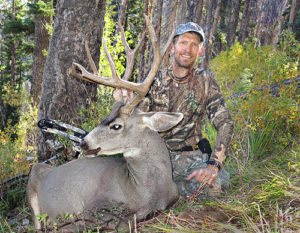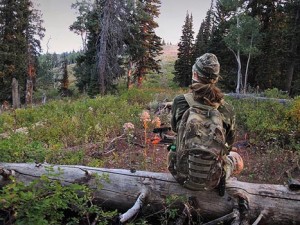The Goal
A dire warning jumped from the pages of last year’s hunt journal: “Plan to hunt the entire 28-day season or plan to fail!” Midway through the 2017 season, the daunting task of arrowing a trophy buck inspired me to write these words. So my goal in 2018 was to hunt the entire season no matter what. I never had this luxury before, mostly due to work obligations. Last year was my longest stint in the woods at 18 days. In order to reach my goal I had to shirk work at every turn, turning down a myriad of jobs, not to mention several fishing trips and other opportunities. I was in for the long haul.
A Quest for Knowledge
I dedicated the first week of the hunt to helping Esther. I would set her up in prime ambush areas while I went off to explore new places and learn everything I could about big buck behavior. This strategy worked out great. Esther finally got a shot at a mature buck, and I got in the habit of collecting data and scouting rather than just hunting.
While exploring a new area one morning, I spotted an old 30-inch wide 3-point buck. I wasn’t completely sold on shooting a 3×3, but he was well out of bow range anyway. Instead I followed his tracks in hopes of learning where big bucks go during the day. The tracks wrapped around the mountain and eventually dropped off a dreadfully steep, shale-rock slope. It was hard to believe a deer would travel so far just to bed down. His route was confirmed by very large tracks and big, green droppings measuring three-quarter inches. They were such large pebbles that I’d always assumed they were elk droppings in the past.
Just when I was about to give up pursuit, the old buck stood up from his bed in a clump of trees 30 yards ahead. He, along with another big buck, took one look at me and hopped away. I stared blankly for a minute, and then had an epiphany: I’ve been hunting wrong my entire life! In 27 years of big game hunting I never realized just how far unpressured deer were willing to go just to bed down for the day. Sure I had my suspicions, but now it was confirmed.

In most of the hunting books I’ve read, the author categorizes big bucks the all same way, whether they are young-mature bucks (3+ years old), older bucks, or old trophy bucks. But young bucks act very differently than old bucks because deer learn exponentially each year they survive. They adapt rapidly to hunters with each encounter, so much so that old bucks (in the 6-10 year range) essentially become unhuntable. Biologists have theorized that 80% of bucks aged 5 years and older will never be harvested, and die natural causes instead. The great majority of bucks taken by hunters are only one or two years old. These “toddlers” have some basic survival instincts, but with so little experience, they cannot effectively avoid hunters. Old bucks on the other hand basically evolve into a completely different animal, so you need to hunt them differently.
Perfect Creatures
Mule deer are the most perfect creature I know of, even better, I dare say, than humans, at least from Nature’s perspective. Here’s what I mean: Deer ears are 10 times larger than ours; they hear everything. Their 310-degree field of view and night vision overshadows our own narrow focus. Their nose is tremendous, shaping their entire head into an olfactory funnel capable of smelling danger a mile away. Every big buck is built like a linebacker; muscular and lean, with the strength and agility to blast away from hunters for miles before setting up shop on some distant, near-vertical slope. Then there’s intelligence—but a different kind of intelligence. It’s widely known that intelligence is the human’s only advantage over the buck (weapons, optics, camouflage, etc. are all products of our intelligence). Yet 80% of bowhunters fail each year because they cannot beat the deer’s seemingly simple intelligence.
From first to last light the hunter gathers information and formulates a series of well thought-out plans to ambush his four-legged foe. The deer, on the other hand, catches the slightest human scent, and without actually seeing the hunter, completely alters his behavior so he’ll never cross our path again. Instantly he goes nocturnal; his evening routine becomes a night routine. He moves from bed to feed on a completely different route and schedule. Simultaneously, he decides to go a few days without water just to keep a low profile. And for the rest of the hunt that buck is never seen. All of this occurs in the buck’s little brain with lightning strike brilliance and hardly a conscious thought.
In hunting stories, people often state that “the buck made a mistake that morning,” or, “I just had to wait for the buck to make a mistake.” The truth is that big bucks don’t make mistakes, they just get unlucky. Every step a deer takes is deliberate, with the purpose of conserving energy and surviving. It’s people who make mistakes—continuous mistakes, actually—and then once in a while we get lucky. The buck is not only “smart” at surviving, but mentally tough from living in the cruel woods 365 days a year. He’s accustomed to constant pain, fear, and discomfort. So it’s hardly a chore for him to avoid a bow-toting hunter who can barely get own his lazy butt up the mountain. Worse yet, while we clamber around the mountain, complete with frustration, the buck sits in the shade of a seemingly random tree, half-asleep, and chewing his cud. Simply put, he’s vastly smarter at surviving than we are at hunting him. Thus, the mighty mule deer buck is God’s perfect creature, perhaps even better than perfect.
The Draggerbuck
Speaking of frustration, week one brought me face to face with a pair of velvet-clad bull elk. For years I fantasized about harvesting a bull in velvet, but these elk spotted me first and blew out of the area…permanently. Esther went home after the first week and I was left alone; just me, my tent, and the mountain. One day, while driving up a nasty dirt road in the velvet elk area, I glimpsed a wide deer butt in the trees. I backed up and was befuddled to see a massive antler glued to the head of an enormous sway-belly buck just 10 yards off the road! Long story short, I spent the next four days tracking that buck through heavy timber.

Back and forth he went with no apparent pattern. All I could glean from this fruitless endeavor was that he dragged his right, rear leg, likely the result of a past human encounter. So I called him the “Draggerbuck.” I set up a trail camera in the area and eventually caught the old warrior on film. Thank goodness he was only a 3×4, because I was beaten and abandoned the pursuit altogether.
Putting it All Together
By the third week I’d seen a lot of new country and a lot of mediocre bucks; so many bucks that I gave up counting them. I’d fallen into a monotonous rhythm: Hunt prime feed at first light, then after 9:30 or so, when the deer had bedded, I’d go on an intel-gathering mission, following big tracks along travel routes while searching for likely feed, water, and bedding areas. Knowing that bucks will go to any horrible place just to avoid hunters, I really pushed myself. Around midday I would drag my sore feet back to camp for lunch and try to catch a “crap-nap” before setting out again. (Daytime sleep was rare and often interrupted). Then, in the early afternoon I’d head back out to explore prime areas and work bed-to-feed routes.
Through it all I never had a bad day because I was learning so much. Each day I returned to camp with a handful of clues—puzzle pieces if you will—that I’d picked up, photographed, or noted in my field journal. During periods of downtime, I meticulously pieced things together until a picture gradually developed. Sure there were gaps here and there, holes to remind me that the pieces are infinite, and can’t all be found. But we’re not meant to know everything; we can only get close. Some pieces probably got vacuumed up, and the dog probably ate some. But the picture was becoming clear and just what I’d hoped for: A monster buck, God’s most perfect beast, standing majestically in the timber, stoic and powerful, with a gleaming coat of coarse-gray fur, his massive antlers glistening above his muscular neck and wizened face. Dramatic, pastel-painted clouds loom overhead, and there’s a title at the bottom, barely visible in gold calligraphy etched in a boulder below his hooves. One word: UNTOUCHABLE. What a picture.
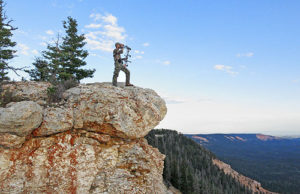
In one of my secret areas I can glass an adjacent mountain peak where a band of bucks often feed late into the morning and then take a predictable route through the pines towards a known bedding area. I had the wind right one evening, so I took my time carefully working into the timber in hopes of ambushing the bucks as they came up to feed. I worked carefully through the thick timber until I found the perfect ambush point between two deer trails and set up there for the evening. I sat motionless until the whole mountain and even the squirrels forgot I was there. I listened intently and glassed often, but nothing happened. As darkness fell I stood up in dismay and wondered deeply, how can I be better than perfect?!
My Mountain Home
A lot happens in 27 days of hunting. I found a couple broken arrowheads and what appears to be a spear tip fashioned of pale blue flint. One night a horrible, screeching witch-monster (or something) walked past my tent at 2:00 am. 27 years of hunting and I’d never heard such an awful noise in the woods! It woke me from a nightmare and I lied there frozen in terror, listening as the monster moved through the trees. I slept with my revolver close that night, and then, undeterred, resumed normal hunting activities the following morning.

The woods are cruel, I’ve decided. They may seem benign to the uninitiated, but to the veteran hunter they’re downright mean. Big buck areas are often protected by a near impenetrable network of barking squirrels, doe snorts, and crackling ground cover. Trying to navigate these obstacles is a daily exercise in futility. Squirrels are the worst and can effectively ruin a hunt. Observe any buck when a squirrel fires up with its relentless, mindless barking. The buck whips his head around and stares in that direction. The older bucks won’t even look, they just walk away.
It gets worse in September when the squirrels have amassed a collection of pine cones and become territorial. The entire pine forest becomes gridded out as squirrel territory. But there’s more going on than just random barking. Oftentimes, the obnoxious rodent simply ignores me until I’ve crawled into bow range. At that point, he seems to have a moral responsibility to alert the buck to my presence. I suspected this before, but now I believe it. Here’s one example: I’m sneaking down a trail when I hear some rustling 20 yards ahead. I crouch down as a mature 4×4 buck steps into view. As I raise my binos for a closer look, a nearby squirrel loses his mind. Then a chipmunk joins in. The buck turns around and glares at me before nervously moving off. This happens all the time, and now, at risk of sounding insane, I fully believe the squirrels are protecting the deer from hunters.
Week 4: Hell Week
Twenty days afield wears on a guy. Days and days go by without speaking to anyone. I stave off loneliness well enough, but then there are the constant bugs, heat, dust, and the crappy air mattress taking its toll on my spine. Weary exhaustion from waking too early, hiking all day, and getting to bed late makes time go by in a blurry haze. Days are very long and time is perceived differently. What day is it, I often wonder.
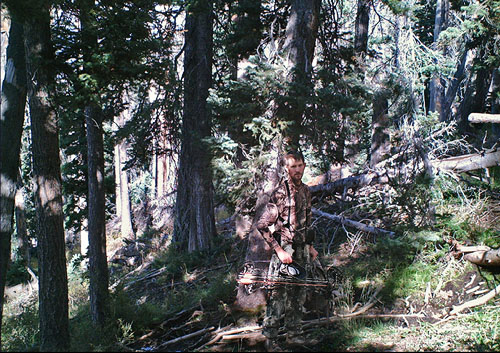
Summer gradually changes to fall; mornings grow cooler and evenings grow shorter. Suddenly it’s a new month, a new moon, and a whole different season. Then there’s dinner: a can of soup, the same kind every night, alone in the dark, sometimes with moths floating in it. But you get used to it. Still, this hunt feels tougher than most, probably because work- and home-life were so stressful preceding the hunt. It was a record year for ripped off, even by good friends, so I carried a lot of negative energy into this hunt. But I suppose it’s easier to spend a month in the woods when you’re disgusted with humanity.
As I sit in the dark, rhythmically slurping my soup, I suddenly realize that everything back home is a luxury. I ask myself, what do I really need to survive? The forest mind, now focused by chronic stinging silence, sees clearly that the vast majority of what consumes our lives is totally unnecessary. The constant din of technology—the TV, phone, internet, ads—is all distractions, even dangerously distracting, because these digital devices distract us from what really matters—purpose, meaning, friends and family. These are digital toxins, stealing away our precious time and scattering our minds. Modern man is becoming an aberration, the byproduct of over-consumerism and selfishness perpetuated by technology and too much information.
That ubiquitous phone-device we poke at all day is the portal from whence the monster comes. It feels like tentacles around my neck. Being self-employed, I live project to project, not by a wage. I haven’t had a paid vacation day in almost fifteen years, so time is valuable. But my phone rings and beeps all the time, interrupting my focus and wrecking my productivity. 90% of the time it’s no one I want to talk, or worse yet, scammers and crooks, seething vultures prying at my wallet and vying for my life’s energy. Even the device itself is constantly trying to sell me something, begging for updates or demanding upgrades. Like I need an upgrade; if anything, I need a downgrade!
Technology has gone too far. It’s a detriment to natural life. It’s ridiculous and abhorrent. Sci-fi predicted our fate a long time ago, and now, here in the future, the machine really has killed us, we just don’t know it yet. I shudder at the thought of returning home. I love the mountain; it’s my rescuer.
The Big One
By week four I’d seen nearly a hundred bucks and only two were worthy of my arrow (180 inches or better). 2% sucks, but it’s still better than most places in Northern Utah. Week four is also fraught with regret. That big 4×4 I passed up early in the season suddenly doesn’t seem so small. I busted him low, then high, and that was the last I saw of him. He changed mountains altogether, went nocturnal, and practically stopped existing. The following week I went looking for him and in his stead was a beautiful 4×5. I passed him too, first at 15 yards and again at 40. Now I’d be happy with either one. But I was convinced there was a bigger one lurking somewhere.
Well, I met that bigger buck with only five days left in the hunt. I estimate him at 190 gorgeous inches. I left camp early that morning, heading to the same far-off ridge where I chased the 30-inch buck early on. Just as the sun began streaming through the trees I heard a swishing sound in the dry brush, and out popped a monster buck 50 yards away. He was a majestic 4×4 tank-of-a-deer, beautiful and old. He was feeding broadside on a steep slope, barely visible in the thick pines. I pulled an arrow, but there was no shot. The buck was working steadily towards the only opening in the forest when a squirrel fired up. Then the wind began to swirl. The buck looked around nervously.
Realizing my only chance at a great buck was about to fall apart, my adrenaline surged and I began shaking like a little girl. The buck continued, slower now. I was coming unglued; my heart pounded and my hands shook. When he finally sauntered through the shot window, I settled my dancing sight pin best I could and hit the release. The arrow took a last minute nose dive into the dirt and the buck smashed away unscathed. After a minute of disgust, I raised my binos and lo and behold, there he was, deep in the woods, antlers sprawling through the trees. He was scowling at me—really scowling—like I’d never seen a deer do before. We stared at each other for several minutes before he finally turned and melted away.
With only four days left I hammered the monster buck area relentlessly. I found two prime feed areas and two prime bedding routes all bearing huge, pebble droppings. I put in full days afield, ghosting through the woods tirelessly, but I never caught up with that buck again. The great, unsolvable problem was navigating the “gauntlet” each morning. The whole area was booby trapped with does, squirrels, swirling winds, and lesser bucks sprinkled around perimeter. The bucks had the decency of just B-lining out of there, but the does were evil. They snorted, stomped, and sprinted around in circles alerting the entire forest to my presence. By the time I got to the big buck area, everything was blown out. With only three days left, and painfully aware of my empty freezer back home, I lowered my standards. Now any mature buck was good enough.
Day 27
Friday, September 13; only two days left. There was a short sentence scribbled on my bow hand in heavy ink: This is IT! Everything I’d endured all year came down to this. Besides, you never know which hunt might be your last. I took the same route that morning and by some miracle made it through the gauntlet. But as expected, the prime area was empty.

The secondary area was a third-mile away, so I needed to hurry. I was trotting through the woods at 7:45 when I spotted two small bucks feeding a short distance ahead. When I paused, a squirrel lit up like its tail was on fire. The two bucks looked back at me, and then promptly shuffled away. To the right a large bush swayed back and forth. A third, unseen buck was raking a bush with his rack, too distracted to hear the squirrel’s alarm. I pulled an arrow just as the bush stopped moving.
The buck, suddenly alarmed by the squirrel, began walking briskly to the right. Through the first opening he came to I glanced at his headgear, four points, good enough. His shoulder appeared and I launched the arrow without a second to spare. The shot felt good and the buck blasted up the near-vertical slope like a cannonball and disappeared in the trees. I stood for a while trying to get my bearings. It all happened so fast.
The blood trail was instant, crimson splashes on both sides of dug-in tracks blasting uphill. After a short bit I found my broken-off arrow covered in bubbly blood. Fifty yards up the mountain, his tracks veered sharply right and there he was, his grey body piled up in some yellow bushes with a heavy antler protruding upward. I knelt down by the beautiful buck and grasped for understanding.
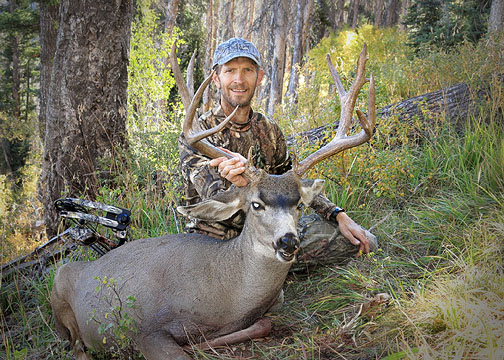
Everything had transpired too quickly to process it. All these years of intense learning had led to this sudden, surprising encounter. I was kind of expecting a grand crescendo to an epic hunt, but instead got an abrupt end to a chance meeting. Nevertheless I was happy; my spirit was full.
Conclusion
The story is really a short one. On a far-off mountainside, somewhere between two prime deer areas, a bowhunter met a random buck, and that’s all. A person can dedicate his whole life to learning about these wondrous creatures—collecting data, photographing, admiring, and pondering—but they’re really beyond comprehension and almost beyond reach. My buck appeared when I needed him to, 27 days into a 28-day season. But the real trophy was knowledge. In just two seasons I’d put in 45 days afield and went farther than ever before while simultaneously expanding my mule deer knowledge ten-fold.
My buck wasn’t really old, nor was his rack really wide, nor tall. He was just a solid 4×4 buck with good mass and some extra cheaters. But considering all I’d been through and how little time was left, I’d say he was perfect, maybe even better than perfect.


